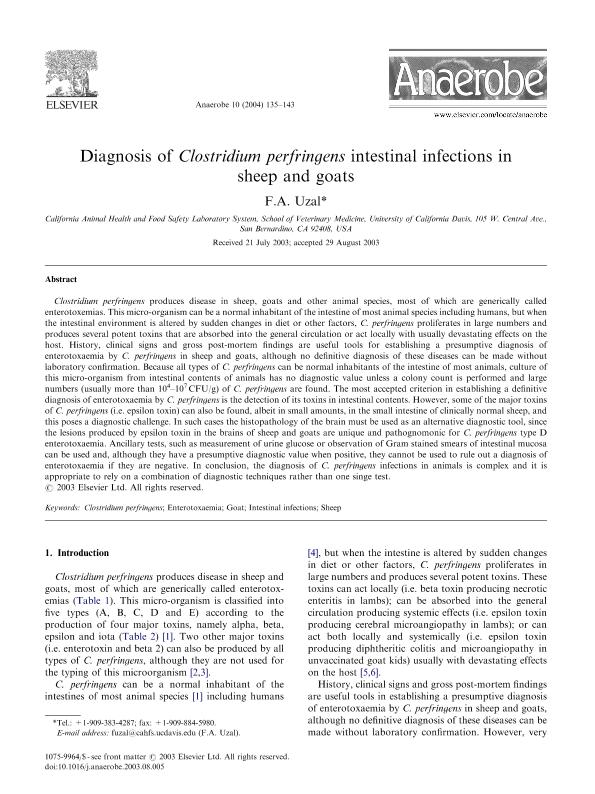Mostrar el registro sencillo del ítem
dc.contributor.author
Uzal, Francisco Alejandro

dc.date.available
2020-09-08T22:34:50Z
dc.date.issued
2004-04
dc.identifier.citation
Uzal, Francisco Alejandro; Diagnosis of Clostridium perfringens intestinal infections in sheep and goats; Elsevier; Anaerobe; 10; 2; 4-2004; 135-143
dc.identifier.issn
1075-9964
dc.identifier.uri
http://hdl.handle.net/11336/113582
dc.description.abstract
Clostridium perfringens produces disease in sheep, goats and other animal species, most of which are generically called enterotoxemias. This micro-organism can be a normal inhabitant of the intestine of most animal species including humans, but when the intestinal environment is altered by sudden changes in diet or other factors, C. perfringens proliferates in large numbers and produces several potent toxins that are absorbed into the general circulation or act locally with usually devastating effects on the host. History, clinical signs and gross post-mortem findings are useful tools for establishing a presumptive diagnosis of enterotoxaemia by C. perfringens in sheep and goats, although no definitive diagnosis of these diseases can be made without laboratory confirmation. Because all types of C. perfringens can be normal inhabitants of the intestine of most animals, culture of this micro-organism from intestinal contents of animals has no diagnostic value unless a colony count is performed and large numbers (usually more than 104–107 CFU/g) of C. perfringens are found. The most accepted criterion in establishing a definitive diagnosis of enterotoxaemia by C. perfringens is the detection of its toxins in intestinal contents. However, some of the major toxins of C. perfringens (i.e. epsilon toxin) can also be found, albeit in small amounts, in the small intestine of clinically normal sheep, and this poses a diagnostic challenge. In such cases the histopathology of the brain must be used as an alternative diagnostic tool, since the lesions produced by epsilon toxin in the brains of sheep and goats are unique and pathognomonic for C. perfringens type D enterotoxaemia. Ancillary tests, such as measurement of urine glucose or observation of Gram stained smears of intestinal mucosa can be used and, although they have a presumptive diagnostic value when positive, they cannot be used to rule out a diagnosis of enterotoxaemia if they are negative. In conclusion, the diagnosis of C. perfringens infections in animals is complex and it is appropriate to rely on a combination of diagnostic techniques rather than one singe test.
dc.format
application/pdf
dc.language.iso
eng
dc.publisher
Elsevier

dc.rights
info:eu-repo/semantics/openAccess
dc.rights.uri
https://creativecommons.org/licenses/by-nc-sa/2.5/ar/
dc.subject
CLOSTRIDIUM PERFRINGENS
dc.subject
ENTEROTOXAEMIA
dc.subject
GOAT
dc.subject
INTESTINAL INFECTIONS
dc.subject
SHEEP
dc.subject.classification
Otras Ciencias Veterinarias

dc.subject.classification
Ciencias Veterinarias

dc.subject.classification
CIENCIAS AGRÍCOLAS

dc.title
Diagnosis of Clostridium perfringens intestinal infections in sheep and goats
dc.type
info:eu-repo/semantics/article
dc.type
info:ar-repo/semantics/artículo
dc.type
info:eu-repo/semantics/publishedVersion
dc.date.updated
2020-09-03T16:57:15Z
dc.journal.volume
10
dc.journal.number
2
dc.journal.pagination
135-143
dc.journal.pais
Países Bajos

dc.journal.ciudad
Amsterdam
dc.description.fil
Fil: Uzal, Francisco Alejandro. Instituto Nacional de Tecnología Agropecuaria. Centro Regional Patagonia Norte. Estación Experimental Agropecuaria San Carlos de Bariloche; Argentina. University of California Davis; Estados Unidos
dc.journal.title
Anaerobe

dc.relation.alternativeid
info:eu-repo/semantics/altIdentifier/url/https://www.sciencedirect.com/science/article/abs/pii/S107599640300146X?via%3Dihub
dc.relation.alternativeid
info:eu-repo/semantics/altIdentifier/doi/http://dx.doi.org/10.1016/j.anaerobe.2003.08.005
Archivos asociados
